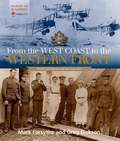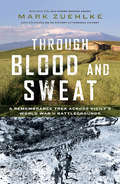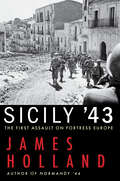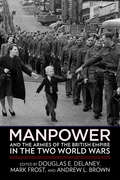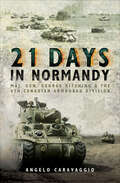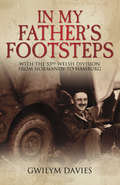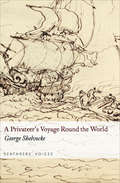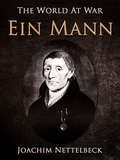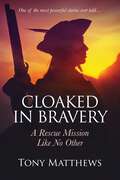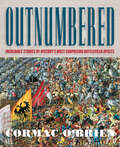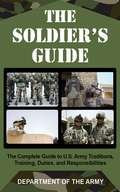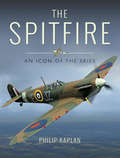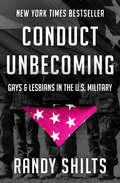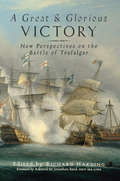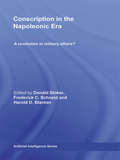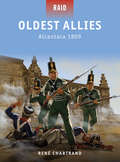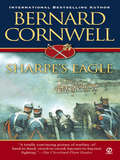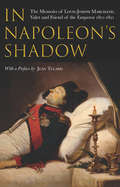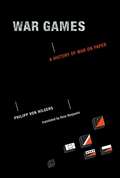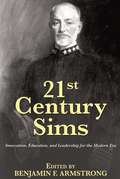- Table View
- List View
From the West Coast to the Western Front
by Greg Dickson Mark ForsytheIt has often been observed that the First World War jolted Canada into nationhood, and as Mark Forsythe and Greg Dickson show in this compelling book, no province participated more eagerly in that transformation or felt the aftershock more harshly than British Columbia. In From the West Coast to the Western Front, Forsythe, host of CBC Radio's mid-day show BC Almanac, marks the 100th anniversary of World War I by teaming with historian Greg Dickson and the ever resourceful BC Almanac audience to compile a sweeping portrayal of that crucial chapter of BC history.Of the 611,000 Canadians who fought for King and Country,55,570 were from British Columbia-the highest per capita rate of enlistment in the country. Of that contingent, 6,225 died in battle, a critical loss to a fledgling province of barely 400,000.Compiling stories, artifacts and photos sent in by BC Almanac listeners from across the province, this volume tells of submarine smuggling, bagpipes lost on the battlefield and of the ongoing struggles by soldiers who made it home. It tells of battles that set records for mass death amid conditions of unequalled squalor, but also of the heroism of front-line nurses and soldiers like George Maclean, a First Nations man from the Okanagan, who won the Distinguished Conduct Medal.By turns devastating, harrowing, insightful and miraculous, these stories reveal much about the spirit and resilience of a people who survived one of history's greatest disasters to build the province we have today.
Through Blood and Sweat
by Mark ZuehlkeAs part of Operation Husky 2013, a group of Canadians walked this route to honour the memory of the nation's soldiers who fought in Sicily seventy years earlier and whose sacrifice has been largely forgotten. Under a searing sun, with Mount Etna's soaring heights always in the distance, a small contingent of marchers trekked each day along winding country roads for between 15 and 35 kilometres to reach the outskirts of a small town or village. Here they were joined by a pipe band, which led them to the skirl of bagpipes in a parade into the community's heart to be met by hundreds of cheering and applauding Sicilians. Before each community's war memorial a service of remembrance for both the Canadian and Sicilian war dead followed. Each day also brought the marchers closer to their final destination-Agira Canadian War Cemetery where 490 of the 562 Canadian soldiers who fell during the course of Operation Husky in 1943 are buried. On July 30-after twenty gruelling days-the marchers were joined here by almost a thousand Canadians and Italians. All joined to conduct a profoundly emotional ceremony of remembrance that ended with one person standing before each headstone and answering the roll call on that soldier's behalf. Mark Zuehlke, author of the award-winning Canadian Battle Series, was one of the Operation Husky 2013 marchers. He uses this arduous and poignant task as a focal point for a contemplative look at the culture of remembrance and the experience of war.
Sicily '43: The First Assault on Fortress Europe
by James HollandA history of World War II’s Operation Husky, the first Allied attack on European soil, by the acclaimed author of Normandy ’44.On July 10, 1943, the largest amphibious invasion ever mounted took place, larger even than the Normandy invasion eleven months later: 160,000 American, British, and Canadian troops came ashore or were parachuted onto Sicily, signaling the start of the campaign to defeat Nazi Germany on European soil. Operation Husky, as it was known, was enormously complex, involving dramatic battles on land, in the air, and at sea. Yet, despite its paramount importance to ultimate Allied victory, and its drama, very little has been written about the thirty-eight-day Battle for Sicily.Based on his own battlefield studies in Sicily and on much new research, James Holland’s Sicily ’43 offers a vital new perspective on a major turning point in World War II and a chronicle of a multi-pronged campaign in a uniquely diverse and contained geographical location. The characters involved—Generals George Patton and Bernard Montgomery among many—were as colorful as the air and naval battles and the fighting on the ground across the scorching plains and mountaintop of Sicily were brutal. But among Holland’s great skills is incorporating the experience of on-the-ground participants on all sides—from American privates Tom and Dee Bowles and Tuskegee fighter pilot Charlie Dryden to British major Hedley Verity and Canadian lieutenant Farley Mowat (later a celebrated author), to German and Italian participants such as Wilhelm Schmalz, brigade commander in the Hermann Göring Division, or Luftwaffe fighter pilot major Johannes “Macky” Steinhoff and to Italian combatants, civilians and mafiosi alike—which gives readers an intimate sense of what occurred in July and August 1943.Emphasizing the significance of Allied air superiority, Holland overturns conventional narratives that have criticized the Sicily campaign for the vacillations over the plan, the slowness of the Allied advance and that so many German and Italian soldiers escaped to the mainland; rather, he shows that clearing the island in 38 days against geographical challenges and fierce resistance was an impressive achievement. A powerful and dramatic account by a master military historian, Sicily ’43 fills a major gap in the narrative history of World War II.Praise for Sicily ’43A New York Times Book Review Editors’ ChoiceNamed a Best History Book of the Year by the Wall Street Journal“Academic histories are all very well, but at times it is a pleasure to sit back and wallow in an old-school military tale of flinty-eyed men doing battle. That is what James Holland, a seasoned craftsman, offers in Sicily ’43.” —New York Times Book Review“Crisp, detailed, and entertaining. Holland refuses to let the legends overshadow the flesh-and-blood soldiers who fought, bled, and died. Sicily ‘43 is an outstanding look at a stepping-stone to victory.” —Wall Street Journal
Manpower and the Armies of the British Empire in the Two World Wars
by Douglas E. Delaney, Mark Frost, and Andrew L. BrownIn the first and only examination of how the British Empire and Commonwealth sustained its soldiers before, during, and after both world wars, a cast of leading military historians explores how the empire mobilized manpower to recruit workers, care for veterans, and transform factory workers and farmers into riflemen. Raising armies is more than counting people, putting them in uniform, and assigning them to formations. It demands efficient measures for recruitment, registration, and assignment. It requires processes for transforming common people into soldiers and then producing officers, staffs, and commanders to lead them. It necessitates balancing the needs of the armed services with industry and agriculture. And, often overlooked but illuminated incisively here, raising armies relies on medical services for mending wounded soldiers and programs and pensions to look after them when demobilized.Manpower and the Armies of the British Empire in the Two World Wars is a transnational look at how the empire did not always get these things right. But through trial, error, analysis, and introspection, it levied the large armies needed to prosecute both wars.Contributors Paul R. Bartrop, Charles Booth, Jean Bou, Daniel Byers, Kent Fedorowich, Jonathan Fennell, Meghan Fitzpatrick, Richard S. Grayson, Ian McGibbon, Jessica Meyer, Emma Newlands, Kaushik Roy, Roger Sarty, Gary Sheffield, Ian van der Waag
The War in Italy: (WW2 #8) (The Ladybird Expert Series #14)
by James Holland* PRE-ORDER YOUR COPY NOW *- Why did the Allies decide to invade Southern Italy?- How did the weather and Italian terrain complicate the fighting?- How did General Mark Clark's Allied Armies win the final battle?Discover the mounting conflict and complex campaigns of the war in Italy. From Operation HUSKY to Clark's final offensive, the Allied campaign tightened the noose around Nazi Germany and saw the end of Italian Fascism, though it was at a cost of high civilian casualty and destruction.AN EPIC OF GRIT, DETERMINATION AND SACRIFICEWritten by historian, author and broadcaster James Holland and with immersive illustrations by Keith Burns, THE WAR IN ITALY 1943-1945 is an accessible and enthralling introduction to these critical battles and their impact on the outcome of World War II
God's Fury, England's Fire: A New History of the English Civil Wars
by Michael BraddickThe sequence of civil wars that ripped England apart in the seventeenth century was the single most traumatic event in this country between the medieval Black Death and the two world wars. Indeed, it is likely that a greater percentage of the population were killed in the civil wars than in the First World War. This sense of overwhelming trauma gives this major new history its title: God’s Fury, England’s Fire. The name of a pamphlet written after the king’s surrender, it sums up the widespread feeling within England that the seemingly endless nightmare that had destroyed families, towns and livelihoods was ordained by a vengeful God – that the people of England had sinned and were now being punished. As with all civil wars, however, ‘God’s fury’ could support or destroy either side in the conflict. Was God angry at Charles I for failing to support the true, protestant, religion and refusing to work with Parliament? Or was God angry with those who had dared challenge His anointed Sovereign?Michael Braddick’s remarkable book gives the reader a vivid and enduring sense both of what it was like to live through events of uncontrollable violence and what really animated the different sides. The killing of Charles I and the declaration of a republic – events which even now seem in an English context utterly astounding – were by no means the only outcomes, and Braddick brilliantly describes the twists and turns that led to the most radical solutions of all to the country’s political implosion. He also describes very effectively the influence of events in Scotland, Ireland and the European mainland on the conflict in England.God’s Fury, England’s Fire allows readers to understand once more the events that have so fundamentally marked this country and which still resonate centuries after their bloody ending.
21 Days in Normandy: Maj. Gen. George Kitching & the 4th Canadian Armoured Division
by Angelo Caravaggio&“Right[s] some of the injustices done to the Canadians&” on their maligned actions during the Invasion of Normandy. &“An absorbing account&” (Firetrench). The Canadian Fourth Armoured Division crossed the Channel in July 1944 to support the invading forces and assist in the Allied attempts to break out of the Normandy beachhead. They were heavily engaged in Operation Totalize and Operation Tractable but have been criticized for their failure to close the &‘Falaise gap&’ and complete the entrapment of withdrawing German forces. Their commander, Major General George Kitching, was relieved of his command after just twenty-one days in action. Angelo Caravaggio reexamines the division&’s performance and particularly that of its leadership. Using new information, he establishes that, despite entering battle for the first time during one of the most challenging phases of Allied operations in August 1944, the 4th Armoured Division, under Kitching&’s leadership, proved resilient and adaptive in overcoming the volatile and unpredictable nature of warfare in Normandy. The combat operations of August 1944 transformed the division into a battle-hardened combat formation that would later distinguish itself through its ability to generate a sustained drive across France out of the chaos and destruction of the Normandy battles. &“The author uses new information to demonstrate the unit did show flexibility and adapted to the battlefield quickly, despite being thrown into battle during one of the Normandy Campaign&’s critical phases. His arguments are detailed and based upon in-depth research, and the book has many detailed maps to help the reader follow the action.&” —Warfare History Network
In My Father's Footsteps: With the 53rd Welsh Division from Normandy to Hamburg
by Gwilym DaviesIn 1944-45, Capt. G.H. Davies served with the hard-fighting 53rd Welsh Division. He was an artillery officer in command of a battery of 25-pdr field guns and saw action from Normandy to the final surrender of Nazi Germany. Capt. Davies was present at the Normandy battles, the fierce fighting for s'Hertogenbosch and the Battle of Arnhem.During the course of the war, Capt. Davies kept a diary and also snatched a few photographs on his treasured camera. When the opportunity arose Capt. Davies liberated a camera from a fallen SS officer and, after the war, had the film developed. The film contained graphic images of the war from the German side of the line.Seventy years on from the events, the wartime diary, the photographs of the guns and the photographs taken by the dead SS officer were the inspiration for the son of Capt. Davies, television producer and writer Gwilym Davies, to undertake an emotional return to the battlefields, which his father had described in his diary.The result of that pilgrimage is an important new book which builds upon the wartime diary and the photographs to produce a powerful record of one man's war service with the guns of the 53rd Welsh Division. The book also contrasts the experience of Capt. Davies with those of the Germans on the other side of the line. Gwilym Davies is himself an accomplished photographer and his photographs of the 70th anniversary celebrations and the memorials provide a poignant counterpoint to the events of 1944.
A Privateer's Voyage Round the World (Seafarers' Voices)
by George ShelvockeIn 1719, Captain George Shelvocke, a poverty-stricken ex-naval officer, appealed for help to an old shipmate, Edward Hughes, who was then part of a consortium fitting-out two privateering vessels to prey on the Spanish in the Pacific. He offered Shelvocke the captaincy of the larger ship but then demoted him to a smaller vessel, and Shelvocke, bitter and revengeful, immediately set off on his own for South America with a semi-mutinous crew, and his much-hated Captain of Marines, William Betagh. After rounding Cape Horn, one of Shelvockes men shot a black albatross an event later to be immortalised in Coleridges Rime of the Ancient Mariner and then, off Chile, with considerable loot onboard his ship, the Speedwell, was wrecked in the Juan Fernandez Islands. Undaunted, he built another vessel and eventually returned to England, via Macao, loaded with Spanish plunder. Back home he was arrested for piracy and defrauding his shareholders, though he argued that he owed the original owners nothing as their ship had been honestly lost. The events were grippingly portrayed in his memoir A Voyage Round the World by Way of the Great South Sea, though some of it was disputed by Betagh and others, and it still reads today as a fast moving, incident-packed tale exposing the world of the maritime mercenaries and privateers, men who would take on anything and everything for Gold!
America's Elite: US Special Forces from the American Revolution to the Present Day
by Chris McnabFrom Roger's Rangers to the Revolution, Civil War, World War I & II, Korea, Vietnam, Iraq, Afghanistan, and the Bin Laden raid, this book covers over 250 years of American Special Forces action. America's Elite takes the reader through some of the most dramatic special forces operations in US history, from sniping British commanders during the Revolutionary War to Riverine incursions in the Mekong Delta in Vietnam, and from demolition missions on D-Day to the SEAL assault on Osama bin Laden's compound in 2011. Training and selection procedures are explained in detail, and the book also describes some of the technologies that have separated regular soldiers from their Special Forces counterparts. Illustrated throughout with striking photography and artworks, America's Elite forms the most comprehensive and visually impressive single-volume guide to US Special Forces available.
Ein Mann: Des Seefahrers Und Aufrechten Bürgers Joachim Nettelbeck Wundersame Lebensgeschichte (The World At War)
by Joachim NettelbeckJoachim Christian Nettelbeck (* 20. September 1738 in Kolberg; 29. Januar 1824 ebenda) war ein durch seine Rolle bei der Verteidigung Kolbergs im Jahre 1807 und seine Autobiographie bekannter deutscher Volksheld. Als Elfjähriger durfte Nettelbeck auf dem Schiff seines Onkels ausnahmsweise nach Amsterdam mitreisen. Dort schlich er sich im Hafen an Bord eines holländischen Ozeanseglers und kam erst auf offener See wieder zum Vorschein. Das Schiff war ein Sklavenhändler und befuhr das Dreieck Westeuropa - Westafrika - Westindien - Westeuropa. Nach neunmonatiger Reise besuchte Nettelbeck bis zur Konfirmation wieder die Schule in Kolberg. Danach begann er eine Seemannsausbildung, zunächst als Schiffsjunge auf Ost- und Nordseefahrern. (Auszug aus Wikipedia)
Cloaked in Bravery: A Rescue Mission Like No Other
by Tony MatthewsExperience the extraordinary journey of a woman who risked everything to follow her man into battle in a desperate attempt to rescue him from the death that inevitably beckoned. Christian, driven by an unwavering devotion to her missing husband, cast aside her comfortable life, family, and even her children to venture into the heart of battle. Disguised as a man, a common foot-soldier, Christian embraced the chaos and carnage of European history's bloodiest conflicts. With a fiery spirit and indomitable courage, she fought alongside men, facing musket-fire, swords, and cannonballs, all in a quest to ensure her husband's survival. Her rollicking good humour, captivating charm, and steely-eyed determination endeared her to comrades and enemies alike. Christian's selflessness knew no bounds. Despite enduring grave wounds, she refused to be deterred, persevering through unimaginable pain. She embodied the strength of a man and the passion of a woman, fearlessly aiding wounded comrades on the battlefield, regardless of the peril she faced. Unveiling a hidden gem of military history, Cloaked in Bravery reveals the compelling tale of a remarkable woman whose devotion and valour transcended the confines of gender. Prepare to be captivated by Christian Davies, as her story unveils a love so powerful it defied all odds.
Outnumbered: Incredible Stories of History's Most Surprising Battlefield Upsets
by Cormac O'BrienFourteen dramatic stories of troops outnumbered but not outmatched—from Hannibal’s Carthaginians to the English at Agincourt to the Red Army in WWII.Even a commander as fearless, self-assured, and battle-hardened as Alexander the Great, leading 40,000 Macedonian troops, must have quailed at the sight that met him as he neared the village of Issus, Asia Minor, in 333 BCE: an unexpectedly and unimaginably vast Persian force of some 100,000 men, spanning the Mediterranean coastal plain as far as the eye could see. For warfare had already demonstrated, and has confirmed ever since, that numerical superiority consistently carries the day. And yet, every once in a while, such lopsided engagements have had an unexpected outcome, and proved to be a crucible in which great leaders, and history, are forged.Outnumbered chronicles fourteen momentous occasions on which a smaller, ostensibly weaker force prevailed in an epochal confrontation. Thus, Alexander, undaunted, devised a brilliant and daring plan that disoriented and destroyed the Persian force and, consequently, its empire. Likewise, during the US Civil War, Confederate Gen. Robert E. Lee, despite being out-positioned and outnumbered more than two to one by Union forces at Chancellorsville, Virginia, hatched an audacious and surprise strategy that caught his enemy completely unawares. Other equally unexpected, era-defining victories are shown to have derived from the devastating deployment of unusual weaponry, sheer good fortune, or even the gullibility of an enemy, as when Yamashita Tomoyuki, commander of 35,000 ill-supplied Japanese troops, convinced the 85,000-strong British Commonwealth army to surrender Singapore in 1942.Together these accounts constitute an enthralling survey that captures the excitement and terrors of battle, while highlighting the unpredictable nature of warfare and the courage and ingenuity of inspired, and inspiring, military leaders who, even when the odds seemed insurmountable, found a path to glory.“There are similar titles about decisive battles and interesting campaigns, but none quite like this . . . an appealing choice for many military history enthusiasts.” —Library JournalIncludes color illustrations and maps
Paullin's History of Naval Administration 1775-1911
by Charles Oscar PaullinThe classic collection of articles from the U.S. Naval Institute Proceedings, now in ebook form.
The Soldier's Guide: The Complete Guide to U.S. Army Traditions, Training, and Responsibilities
by ArmyThis manual condenses important information from a number of U.S. Army regulations, field manuals, and other publications into one crucial volume. Written to answer the many questions asked by soldiers of all ranks in the Army, it covers everything from the history and traditions of the American military to training and service benefits. Find out about such ideals as "The Warrior Ethos" that drive soldiers during a mission and the Army's values of loyalty, duty, respect, selfless service, honor, integrity, personal courage, and discipline. In addition, sections cover ethical reasoning, the basic principles of war, military courtesies, individual combat skills, and more.
The Spitfire: An Icon of the Skies
by Philip Kaplan&“An amazing tribute to the people who designed, built and flew it—a comprehensive history of one of the most beautiful aircraft ever manufactured.&”—Books Monthly The magnificent Vickers Supermarine Spitfire, together with its able partner the Hawker Hurricane, saved Britain from Nazi invasion in the summer of 1940 and irrevocably changed the course of the Second World War. This book from Philip Kaplan celebrates one of history&’s most important weapons in a glorious new light. A British national icon, the Spitfire is the best-known symbol of the war years for generations of Britons. From the deep, haunting growl of its Rolls-Royce engine, to the elegant style of its elliptical wing, it is perhaps the most famous and revered combat airplane ever built. Kaplan investigates just what it is that fuels the Spitfire&’s compelling mystique. During wartime, it held an unrivaled reputation amongst Allied and Axis airmen. Today, it continues to hold aviation enthusiasts in thrall. Kaplan highlights the immeasurable contributions of Spitfire designers Reginald J. Mitchell and Joseph Smith, test pilots Jeffrey Quill, Mutt Summers and Alex Henshaw, and ace Spitfire pilots including Al Deere, Sailor Malan and Pierre Clostermann. All added to the legend of this lovely, but deadly, little fighter. &“Can be considered a &‘Potted History&’ of the Spitfire and its military and civilian service, with particular emphasis being placed on the restoration of AR213. On that basis it will probably appeal to Spitfire aficionados in particular and to aviation and war-bird enthusiasts in general.&”—NZ Crown Mines
Conduct Unbecoming: Gays & Lesbians in the U.S. Military
by Randy Shilts&“A thoroughly researched and engrossingly readable history&” of gay men and women in the American armed forces by the author of And the Band Played On (The New York Times Book Review). Published during the same year the American military instituted Don&’t Ask, Don&’t Tell, and eighteen years before President Barack Obama repealed it, Conduct Unbecoming is a landmark work of social justice and a searing indictment of the military establishment&’s historic bigotry toward its gay servicemen and women. Randy Shilts&’s eye-opening book describes the bravery, both exceptional and everyday, not only of gay soldiers throughout history, but also of gay men and women serving in our modern military. With each anecdote and investigation, Shilts systematically dismantles the arguments against allowing gays to serve in the military. At once a history of the American military and an account of the gay rights movement, Conduct Unbecoming is a remarkable testament to the progress achieved for gays in the military—and a revealing look at how far we have yet to go.
A Great and Glorious Victory: New Perspectives on the Battle of Trafalgar
by Richard HardingIn October 2005 an international naval conference was held at Portsmouth and well-known historians and naval officers from around the world, including Colin White, Brian Lavery, Contre Amiral Remi Monaque and Admiral Sir Jonathan Band, now First Sea Lord, gave a series of papers on aspects of the battle of Trafalgar. Containing a wealth of new information they are now form the core of this book. Twelve chapters cover every aspect of the battle but also explore important associated themes such as the Grand Armee and the invasion threat, and the British defenses against invasion in the years before 1805. On the battle itself there are pieces on the ships, men and the tactics, and important chapters from the French and Spanish perspectives. Perhaps the most groundbreaking contribution is from the Inshore Squadron, a naval war-gaming group, which produced a timeline that is the most accurate yet available and reveals, amongst other things, the nature of the ship-on-ship actions and the timing of some of the set events. Put into its strategic, political and economic context, the battle is brought to life in a way which distinguishes it from all the other accounts that have appeared and offers enthusiasts and historians the most up-to-date and important reassessment that is available.
Conscription in the Napoleonic Era: A Revolution in Military Affairs? (Cass Military Studies)
by Donald Stoker Frederick C. Schneid Harold D. BlantonThis edited volume explores conscription in the Napoleonic era, tracing the roots of European conscription and exploring the many methods that states used to obtain the manpower they needed to prosecute their wars. The levée-en-masse of the French Revolution has often been cited as a ‘Revolution in Military Affairs’, but was it truly a ‘revolutionary’ break with past European practices of raising armies, or an intensification of the scope and scale of practices already inherent in the European military system? This international collection of scholars demonstrate that European conscription has far deeper roots than has been previously acknowledged, and that its intensification during the Napoleonic era was more an ‘evolutionary’ than ‘revolutionary’ change. This book will be of much interest to students of Military History, Strategic Studies, Strategic History and European History.
Oldest Allies - Alcantara 1809
by Mark Stacey Rene ChartrandAlthough somewhat overshadowed by Wellington's main campaign in the north, the Alcantara raid was an outstanding success. The primary objective of alarming and distracting the French forces in Spain was achieved. Furthermore, the raiders also succeeded in preventing a French incursion into Portugal and tied down one of Napoleon's best marshals. There were further raids to come, but the 1809 Alcantara raid delivered a strong, permanent message: that the Anglo-Portuguese were willing and able to strike back against the French, and that they would support their Spanish allies as much as they were able.
Sharpe's Eagle: Richard Sharpe And The Talavera Campaign, July 1809 (Richard Sharpe Adventure Ser. #No. 8)
by Bernard CornwellAfter the cowardly incompetence of two officers besmirches their name, Captain Richard Sharpe must redeem the regiment by capturing the most valued prize in the French Army--a golden Imperial Eagle, the standard touched by the hand of Napoleon himself.
In Napoleon's Shadow: The Memoirs of Louis-Joseph Marchand, Valet and Friend of the Emperor, 1811–1821
by Louis-Joseph MarchandIn 1811, twelve young men were chosen among the families in the Emperors personal service to serve as ushers in his apartments. My mother, attached to the household of the King of Rome as first nurse to the prince, requested this favour for me from the grand chamberlain, the Count de Montesquiou, and it was granted.Louis-Joseph Marchands intimate memoir of his time as Napoleons valet is the last of the significant Napoleonic manuscripts to be translated into English and a unique and precious insight into the last days of Napoleons Imperial project.Serving alongside the Emperor from the apex of his reign and through his eventual demise, Marchand depicts, in remarkable detail, the Russian campaign, the campaigns of Germany and France, Napoleons exile to Elba and subsequent escape, his defeat at Waterloo.Friend and confidante to the leader, Marchand was beside him at the Tuileries during the Hundred Days, and he was present to hear Napoleons last words, France my son the army on the island of St Helena.This sincere and authentic testimony from a man with nothing to hide, nothing to apologise for is both a meticulous historical record and a fresh personal perspective on Napoleon.In this work, Tulard remarks in his preface, the Emperor speaks freely. Listen..Marchand presents the somewhat familiar history of the Emperor's decline as completely new territory through conversations, fond stories and personal encounters'.'Marchand's memoirs, republished in English for the first time in two decades, represent a truly irreplaceable contribution to Napoleonic scholarship. Beyond the Emperor as commander and conqueror, Marchand, from his privileged vantage point, illuminates Napoleon the man in rich and absorbing detail.' - John H Gill
War Games: A History of War on Paper
by Philipp Von Hilgers Ross BenjaminFor centuries, both mathematical and military thinkers have used game-like scenarios to test their visions of mastering a complex world through symbolic operations. By the end of World War I, mathematical and military discourse in Germany simultaneously discovered the game as a productive concept. Mathematics and military strategy converged in World War II when mathematicians designed fields of operation. In this book, Philipp von Hilgers examines the theory and practice of war games through history, from the medieval game boards, captured on parchment, to the paper map exercises of the Third Reich. Von Hilgers considers how and why war games came to exist: why mathematical and military thinkers created simulations of one of the most unpredictable human activities on earth. Von Hilgers begins with the medieval rythmomachia, or Battle of Numbers, then reconstructs the ideas about war and games in the baroque period. He investigates the role of George Leopold von Reiswitz's tactical war game in nineteenth-century Prussia and describes the artifact itself: a game board--topped table with drawers for game implements. He explains Clausewitz's emphasis on the "fog of war" and the accompanying element of incalculability, examines the contributions of such thinkers as Clausewitz, Leibniz, Wittgenstein, and von Neumann, and investigates the war games of the German military between the two World Wars. Baudrillard declared this to be the age of simulacra; war games stand contrariwise as simulations that have not been subsumed in absolute virtuality.
21st Century Sims
by Edited by Benjamin F. ArmstrongFor more than two decades at the beginning of the 20th century William S. Sims was at the forefront of naval affairs. From the revolution in naval gunnery that he led as a junior officer, to his advocacy for the Dreadnaught style all-big-gun battleship, to his development of torpedo boat and destroyer operations, he was a central figure in helping to prepare the U. S. Navy for World War I. During the war he served as the senior naval commander in Europe and was instrumental in the establishment of the convoy system that won the Battle of the Atlantic. Following the war his leadership as President of the Naval War College established the foundations of the creative and innovative Navy that would develop the operating concepts for submarines and aircraft carriers which would lead to success in World War II. Despite his dramatic impact on the U. S. Navy in the first half of the 20th century, Sims is a relatively unknown figure today. Overshadowed in our memory by the World War II generation of strategic Admirals, like Chester Nimitz and Raymond Spruance, he receives little attention from historians or professional naval officers. Despite the fact that he won a Pulitzer Prize for history, hardly anyone reads the books or articles he left as his legacy. This collection of six essays written by Sims illustrates why his thinking and leadership are relevant to the challenges faced in the 21st century. From the perils of military conservatism, to the responsibilities of the professional officer, to military downsizing and reform, he helped lay the foundations of the modern Navy. Armstrong’s introductions and analysis of these essays links them directly to the issues of innovation, professional education, and leadership that are as important at the start of this century as they were at the start of the last.
The Apathetic and the Defiant: Case Studies of Canadian Mutiny and Disobedience, 1812-1919
by Craig L. MantleCanadian soldiers have served their country for centuries, and for the most part they have done so honourably and loyally. Yet, on certain occasions, their conduct has been anything but honourable. Whether by disobeying their legal orders, terrorizing the local population, or committing crimes in general, some soldiers have embodied the very antithesis of appropriate military conduct. Covering examples of unsavoury behaviour in the representatives of our military forces from the War of 1812 to the immediate aftermath of the First World War, The Apathetic and the Defiant reveals that disobedience and mutiny have marked all of the major conflicts in which Canada has participated. Canadian military indiscipline has long been overshadowed by the nation’s victories and triumphs … until now.
